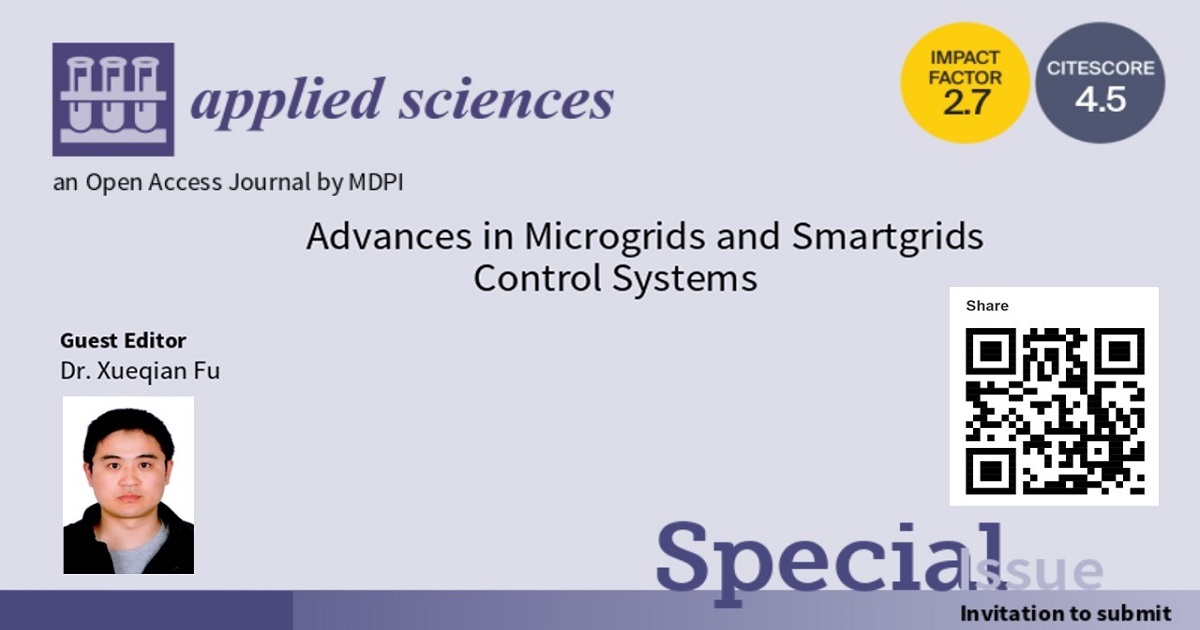Advances in Microgrids and Smartgrids Control Systems
A special issue of Applied Sciences (ISSN 2076-3417). This special issue belongs to the section "Energy Science and Technology".
Deadline for manuscript submissions: closed (20 June 2024) | Viewed by 7051

Special Issue Editor
Interests: rural microgrid; agricultural energy internet; statistical machine learning; smart energy systems
Special Issues, Collections and Topics in MDPI journals
Special Issue Information
Dear Colleagues,
The modern power system is undergoing tremendous changes, especially in the low-carbon and intelligent fields. The large-scale grid connection of photovoltaic power generation and wind power generation has changed the operation and control mode of the power grid. In the field of information science, 6G communication theory and artificial intelligence have developed rapidly. The applications of statistical machine learning and non-orthogonal multiple access communication in power systems may make them more intelligent than before. The intelligent control of microgrids and distribution networks can solve the problems caused by the large-scale grid integration of clean energy.
In this Issue, we will bring together research that discusses and highlights the advances in microgrids and smart grid control systems. Microgrid control theory research involves multiple application scenarios in cities, industries and rural areas. In addition, we believe that artificial intelligence technology, carbon emission reduction technology and wireless communication technology are of great significance for the improvement of smart grid control. This Special Issue aims to publish high-quality, original research papers in the overlapping fields of:
- Smart grid control and operation;
- Smart grid planning under uncertainty;
- NOMA in smart grid applications;
- Net zero-carbon emission microgrid;
- Photovoltaic power generation forecast;
- Weather-based interruption prediction;
- Microgrid resilience to extreme weather events;
- Integration of bifacial photovoltaics in agrivoltaic systems.
Dr. Xueqian Fu
Guest Editor
Manuscript Submission Information
Manuscripts should be submitted online at www.mdpi.com by registering and logging in to this website. Once you are registered, click here to go to the submission form. Manuscripts can be submitted until the deadline. All submissions that pass pre-check are peer-reviewed. Accepted papers will be published continuously in the journal (as soon as accepted) and will be listed together on the special issue website. Research articles, review articles as well as short communications are invited. For planned papers, a title and short abstract (about 250 words) can be sent to the Editorial Office for assessment.
Submitted manuscripts should not have been published previously, nor be under consideration for publication elsewhere (except conference proceedings papers). All manuscripts are thoroughly refereed through a single-blind peer-review process. A guide for authors and other relevant information for submission of manuscripts is available on the Instructions for Authors page. Applied Sciences is an international peer-reviewed open access semimonthly journal published by MDPI.
Please visit the Instructions for Authors page before submitting a manuscript. The Article Processing Charge (APC) for publication in this open access journal is 2400 CHF (Swiss Francs). Submitted papers should be well formatted and use good English. Authors may use MDPI's English editing service prior to publication or during author revisions.
Keywords
- uncertainty
- photovoltaic
- agrivoltaic system
- rural microgrid
- zero-carbon emission
- extreme weather event
- agricultural energy internet
- statistical machine learning
- non-orthogonal multiple access
Benefits of Publishing in a Special Issue
- Ease of navigation: Grouping papers by topic helps scholars navigate broad scope journals more efficiently.
- Greater discoverability: Special Issues support the reach and impact of scientific research. Articles in Special Issues are more discoverable and cited more frequently.
- Expansion of research network: Special Issues facilitate connections among authors, fostering scientific collaborations.
- External promotion: Articles in Special Issues are often promoted through the journal's social media, increasing their visibility.
- Reprint: MDPI Books provides the opportunity to republish successful Special Issues in book format, both online and in print.
Further information on MDPI's Special Issue policies can be found here.





